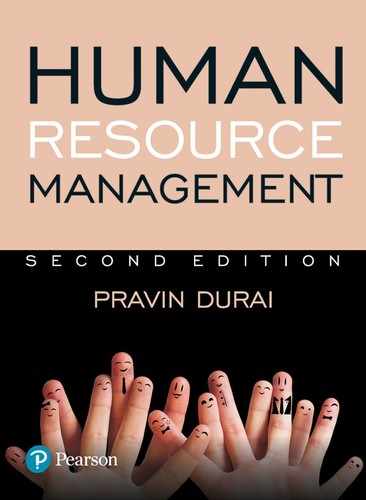Contents
PART I HUMAN RESOURCE MANAGEMENT—A CONCEPTUAL FRAMEWORK
1 Introduction to Human Resource Management
HRM and Personnel Management (PM)
Line Versus Staff Authority of HRM
2 Strategic Human Resource Management—A Framework
Meaning of Strategic Human Resource Management
Features of Strategic Human Resource Management
Differences Between SHRM and HRM
Models of Strategic Human Resource Management
Steps in the Strategic Management Process
Benefits of a Strategic Approach to HRM
3 The Evolution and Environment of Human Resource Management
The Human Resource Management Environment
Environmental Scanning—An Over view
The Environmental Scanning Process
Important Terms in Job Analysis
Techniques of Data Collection in Job Analysis
Challenges Affecting the Effectiveness of Job Analysis
Environmental Influence on the Job Design
Critical Components of Job Design
Characteristics of Human Resource Planning
Significance of Human Resource Planning
Factors affecting Human Resource Planning
Human Resource Planning Process
Requirements for Effective HR Planning
Barriers to the HR Planning Process
Steps in the Recruitment Process
Recruitment Practices in India
Differences Between Recruitment and Selection
Phases of the Selection Process
Employment Application Forms/Blanks
Strategy for an Effective Interview Process
Weaknesses of the Interview Method
The Selection Process in India
8 Orientation, Socialization and Placement
Purpose of Employee Orientation
Process of Orientation Programme Development
An Effective Orientation Programme
Differences Between Orientation and Socialization
Dimensions of Organizational Socialization Strategies
PART III HUMAN RESOURCE DEVELOPMENT
9 Career Planning and Guidance
Important Terminology Used in Career Planning
Responsibility for Career Planning and Development
Limitations of Career Planning
Measures to Improve the Effectiveness of Career Planning
Significance of Employee Training
Steps in an Employee Training Process
Evaluation of a Training Programme
Effects to be Measured in Evaluation
Conditions Necessary for an Effective Training Programme
Significance of Management Development
Goals of Management Development
Steps in a Management Development Process
Methods of Management Development
Evaluation of the Development Programme
Management Succession Planning
Characteristics of Organizational Development
Key Concepts in Organizational Development
Objectives of Organizational Development
The Organizational Development Process
Approaches to the Study of Organizational Development
Types of OD Intervention Programmes
Benefits of OD Intervention Programmes
PART IV HR EVALUATION AND COMPENSATION
13 Performance Evaluation and Job Evaluation
Performance Evaluation: An Introduction
Performance Evaluation: An Overview
Performance Management: An Overview
Objectives of Performance Evaluation
Uses of Performance Evaluation
Determining the Criteria for Performance Evaluation
The Process of Performance Evaluation
Selection of the Evaluator for Conducting the Performance Evaluation
Performance Evaluation Methods
Issues in Performance Evaluation
Steps to Overcome the Problems in the Evaluation Process
The Post-performance Evaluation Interview: An Overview
Characteristics of Job Evaluation
Measures to Enhance the Effectiveness of Job Evaluation
14 Compensation Administration
Objectives of Compensation Administration
Factors Influencing Compensation (Wages and Salary) Administration
Steps in Compensation Administration
Challenges in Compensation Administration
The Wage Incentive Planning Process
Prerequisites for a Good Incentive Scheme
Evaluation of Wage Incentive Schemes
PART V HR MAINTENANCE AND MOTIVATION
Objectives for Providing Employee Safety
Steps in an Employee Safety Programme
Essentials of an Effective Safety Programme
Statutory Provisions Concerning Employee Safety and Health
Behaviour-based Safety Management and Approach
17 Employee Welfare and Social Security
Objectives of Employee Welfare
Employee Welfare Responsibility
Limitations of Welfare Measures
18 Workers’ Participation and Empowerment
Essential Prerequisites for Effective WPM
Obstacles faced by Effective WPM
Essentials of a Sound Promotion Policy
Characteristics of Industrial Relations
Objectives of Industrial Relations
Major Players in Industrial Relations
Approaches to the Study of Industrial Relations
Factors Influencing Industrial Relations
Essentials of Effective Industrial Relations
21 Discipline and Disciplinary Action
Characteristics of Employee Discipline
Symptoms and Causes of Indiscipline
Steps in Establishing a Disciplinary Action Procedure
Essential Steps to Enhance the Effectiveness of Discipline Meetings
Elements of a Good Disciplinary System
Douglas McGregor’s Hot Stove Rule of Discipline
Techniques of Grievance Identification
Essentials of a Good Grievance Procedure
Benefits of the Grievance Redressal Procedure
Statutory Provisions Concerning the Grievance Redressal Procedure in India
23 Industrial Disputes and Collective Bargaining
Characteristics of Industrial Disputes
Objectives of the Industrial Disputes Act, 1947
Investigation and Settlement of Disputes
Classification of Collective Bargaining
The Collective Bargaining Process
Essentials of Effective Collective Bargaining
Trade Union Goal Accomplishment Strategies and Actions
Why do Workers Join Trade Unions?
Challenges Facing the Trade Union Movement
Essential Conditions for an Effective HR Audit
26 The Human Resource Information System (HRIS)
Applications of an HRIS in Human Resource Management
Conditions Essential for an Effective HRIS
Objectives of Human Resource Accounting
Approaches to Human Resource Accounting
Uses of Human Resource Accounting
Weaknesses of Human Resource Accounting
28 Ethical Issues in Human Resource Management
Ethics and Human Resource Management
Need for Ethical Policies and Codes
Approaches to Ethical Issues in Organizations
Factors Influencing Ethical Behaviour at Work
Role of HRM in the Development of Ethical Behaviour
Guidelines for International Business Organizations on Ethical Issues
Ethical Dilemma in Global Wage Payment
29 International Human Resource Management
Features of International HRM (IHRM)
Differences Between IHRM and Domestic HRM
Reasons for the Growth of IHRM
Strategic International Human Resource Management
Cross-culture Management in IHRM
Factors Determining the Outcome of International Assignment of Employees
List of Dos and Don’ts in Developing and Implementing Global HR Practices
Formula for Important HR Metrics
Prerequisites for Success of HR Metrics
31 Human Resource Management in Small and Medium Enterprises
Human Resource Management Practices in Large-scale and Small-scale Enterprises—A Comparison
Green Human Resource Management
